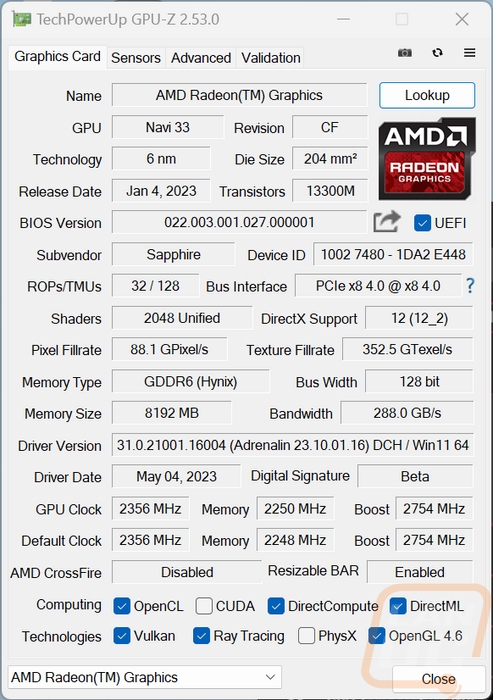WWhen I think of AMD cards, Sapphire is still the first brand that comes to mind. Much like EVGA did for Nvidia for years. So with today's launch of the Radeon RX 7600, in addition to checking out the reference card which we already have done, I’ve also got the Sapphire RX 7600 Pulse. Their Pulse brand tries to bridge the gap between performance and affordability by cutting out things like RGB lighting. With a focus on 1080p performance, that is the exact mindset needed, so I’m excited to see what the Sapphire RX 7600 Pulse has to offer and to find out how the RX 7600 performs with a slight overclock and a hopefully it has better cooling performance than the reference design. So let’s dive in and see what the RX 7600 Pulse is all about.
Product Name: Sapphire RX 7600 Pulse
Review Sample Provided by: Sapphire
Written by: Wes Compton
Amazon Affiliate Link: HERE
All about the RX 7600
I spoke about it in yesterday's Nvidia RTX 4060 Ti review and I mentioned it in the opening here but it is easy to forget that a majority of gamers are playing at 1080p. With so many new cards coming out and being so capable at 1440p and 4k you would think that is what most people are using. So with the 65% of gamers who are playing at 1080p a lot of those higher-end cards might get them higher frame rates but in most cases, it would be overkill. Obviously, if you are planning a monitor upgrade soon it would still make sense to focus on a card capable of that. But if 1080p is still in your future, why not focus on cards designed specifically for that? The RX 7600 that we are looking at today falls into that category but if you were curious you can usually get a good idea of what a card's target is just by looking at the VRAM. AMD has their lineup broken up this way and Nvidia is similar as well. You can see AMDs current lineup in the picture below from AMDs presentation, interestingly we can see that right now they still have the RX 6650 XT and the RX 6600 as well in their 1080p focus, and because they skipped from their new RX 7900 XT, and RX 7900 XTX down to the RX 7600 everything in the lineup in between that is still from the 6000 Series.
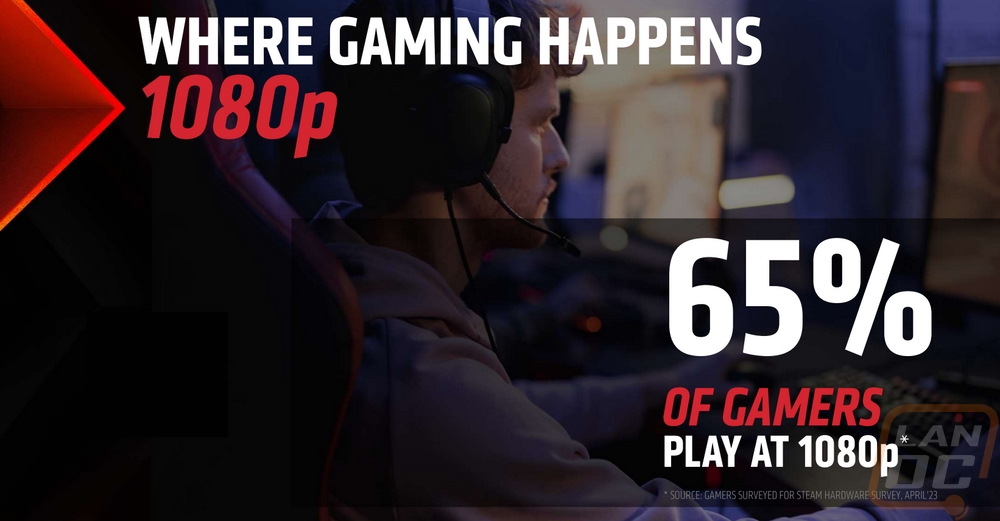
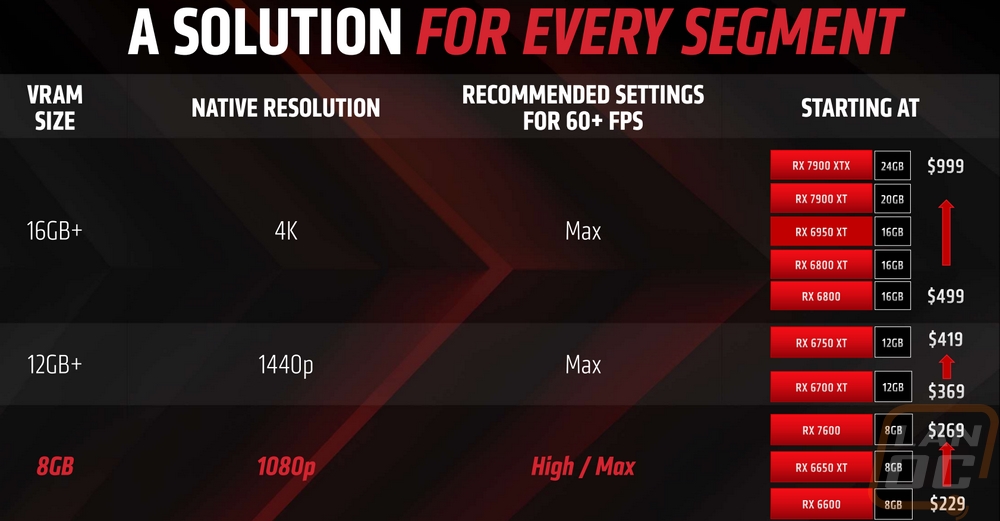
When comparing the new RX 7600 to the previous generation card, the RX 6600 we can see that the transistor count has increased from 11.1 billion to 13.3 billion but with the smaller 6nm build process the die size has also gotten smaller going from 237 mm² to 204 mm². In that smaller space, AMD has increased the compute unit count from 28 up to 32 and the new architecture also adds in the new AI accelerators as well. The stream processor count has improved from 1792 up to 2048. The RX 7600 also has higher game and boost clock speeds with the new boost clock at up to 2655 MHz. All of this together has made huge improvements in the single precision performance which on the RX 6600 was up to 8.93 TFLOPS and the RX 7600 is now up to 21.75 TFLOPS. The 8GB GDDR6 hasn’t changed at all, this is still a 1080p focused card and the RX 7600 still has a 128-bit memory bus but AMD did increase the memory speed up to 18 Gbps. With the higher clock speeds, even the power efficiency that the smaller build process wasn’t enough, the RX 7600 has a higher total board power of 165 watts compared to the RX 6600’s 132 watts. The smaller die size did help with the pricing as well as not being in the middle of a crypto (and covid) fueled card shortage with the price dropping from $329 of the RX 6600’s launch price down to $269 for the RX 7600.
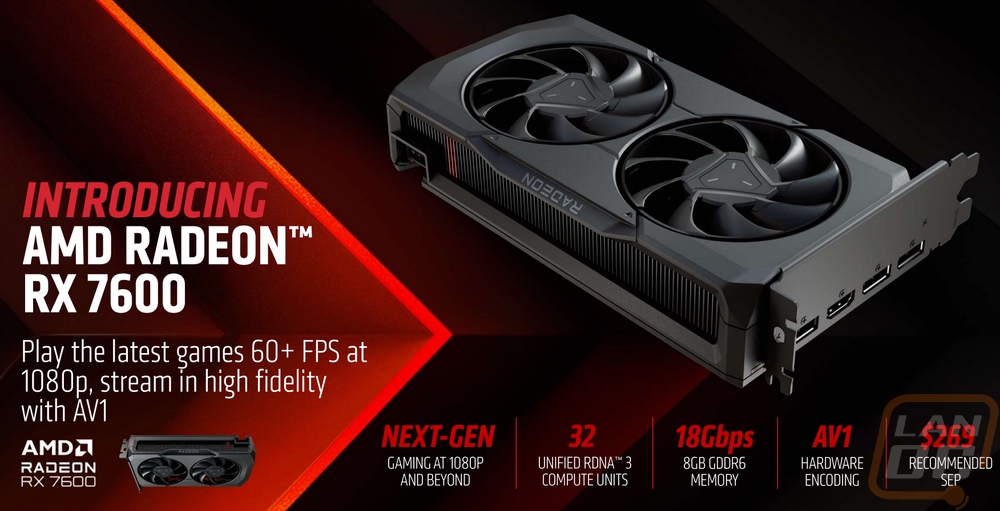
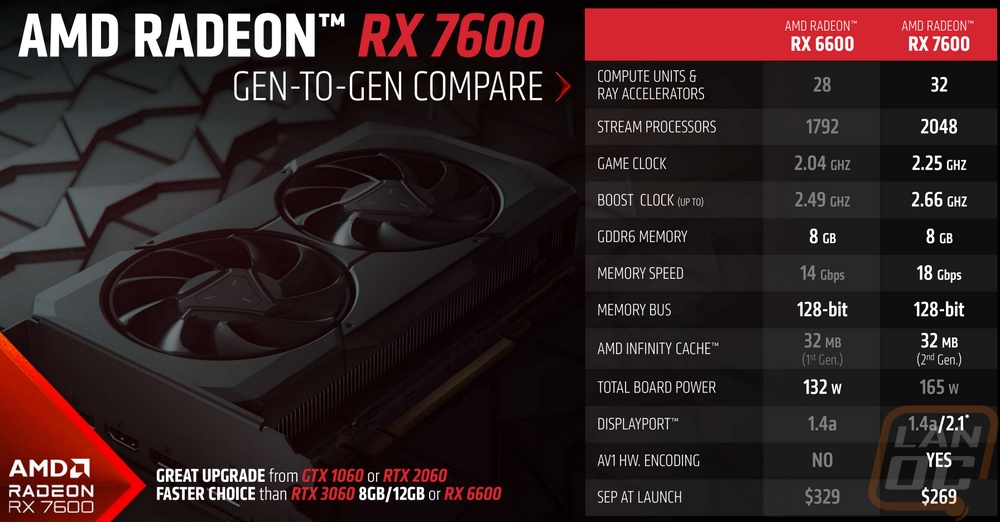
|
Specifications |
Radeon RX 7600 |
Radeon RX 6600 |
|
Architecture |
RDNA 3 |
RDNA 2 |
|
Manufacturing Process |
6nm |
7nm |
|
Transistor Count |
13.3 billion |
11.1 billion |
|
Die Size |
204 mm² |
237 mm² |
|
Compute Units |
32 |
28 |
|
Ray Accelerators |
32 |
28 |
|
AI Accelerators |
64 |
- |
|
Stream Processors |
2048 |
1792 |
|
Game GPU Clock |
2250 MHz |
2044 MHz |
|
Boost GPU Clock |
Up to 2655 MHz |
Up to 2491 MHz |
|
Peak Single Precision Perf. |
Up to 21.75 TFLOPS |
Up to 8.93 TFLOPS |
|
Peak Half Precision Perf. |
Up to 43.5 TFLOPS |
Up to 17.86 TFLOPS |
|
Peak Texture Fill-Rate |
Up to 339.8 GT/s |
Up to 279 GT/s |
|
ROPs |
64 |
64 |
|
Peak Pixel Fill-Rate |
Up to 169.9 GP/s |
Up to 159.4 GP/s |
|
AMD Infinity Cache |
32 MB (2nd Gen) |
32 MB (1st Gen) |
|
Memory |
8GB GDDR6 |
8GB GDDR6 |
|
Memory Speed |
18 Gbps |
14 Gbps |
|
Effective Memory Bandwidth w/AMD Infinity Cache |
Up to 476.9 GB/s |
Up to 412.9 GB/s |
|
Memory Bus Interface |
128-bit |
128-bit |
|
PCIe Interface |
PCIe 4.0 x8 |
PCIe 4.0 x8 |
|
Total Board Power |
165W |
132W |
|
Launch MSRP |
$269 |
$329 |
AMDs presentation did also highlight that they are supporting AV1 which is starting to pick up and will be very important. AV1 allows for better video quality at lower bitrates which has a few important uses. For streamers or if you are streaming your game on Discord to your friends this allows for better quality without clogging up your upload connection for those of us with cable internet. It’s not only streamers who will benefit though, AV1 support means less data transferred for companies like YouTube as well.
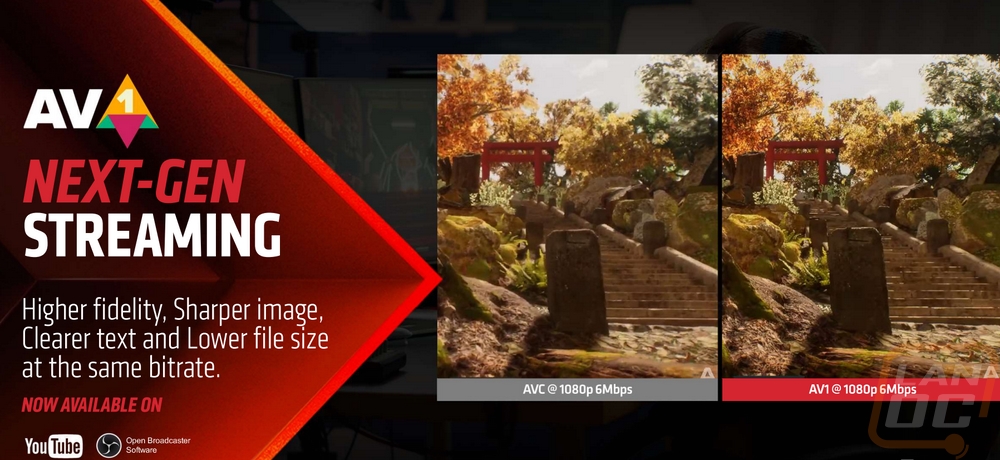
Before getting into testing I did also run GPUz to double-check that our clock speeds match up with the specifications. The Sapphire RX 7600 Pulse has a boost clock of 2751 MHz which is 96 MHz over the reference card's 2655 MHz boost clock speed. It also has a higher default clock speed of 2356 Mhz over the 2250 MHz on the reference card. They aren’t a huge overclock, but a small bump at least. Beyond that GPUz documents, our BIOS revision number in case that is needed in the future as well as the driver I tested on which is the Adrenalin 23.10.01.16 beta press driver from ahead of the launch.
